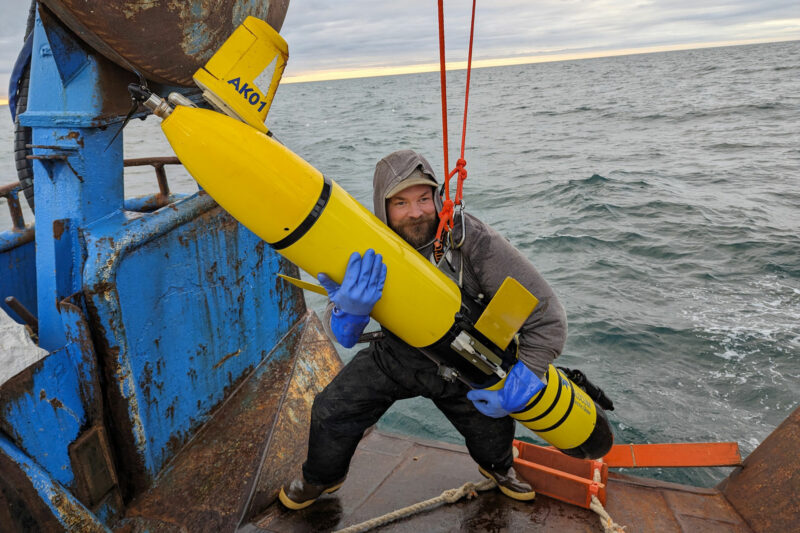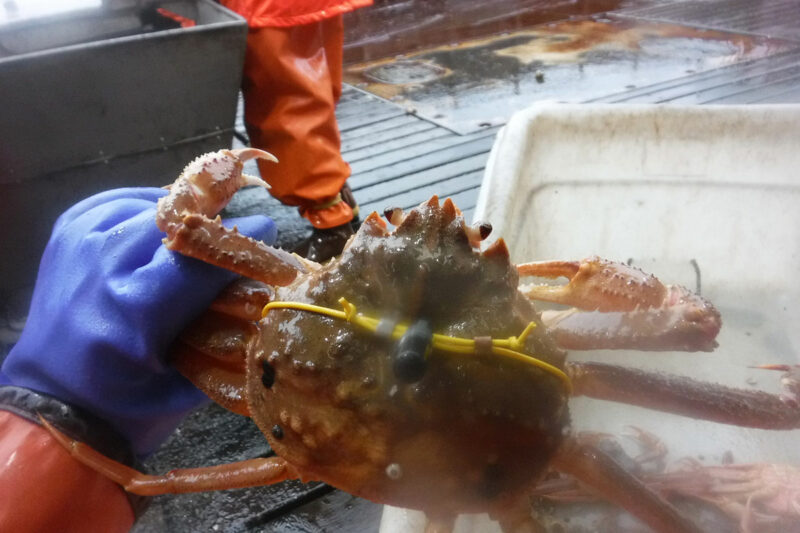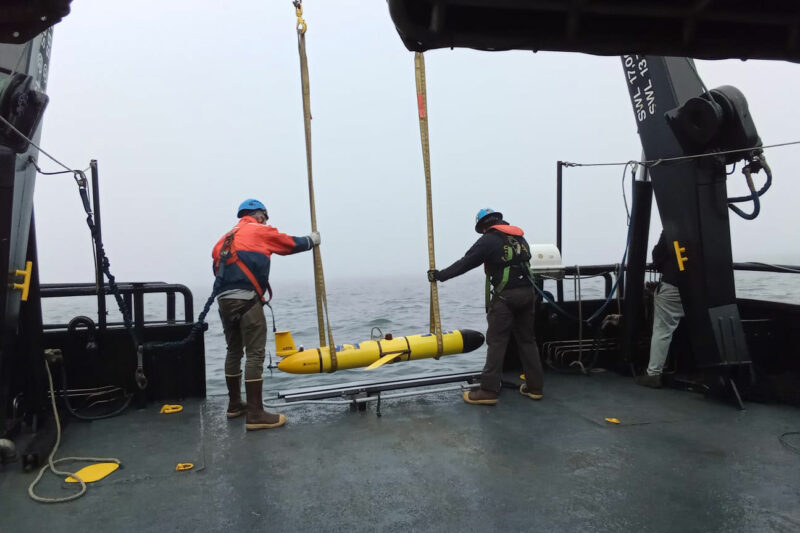AOOS supports a fleet of autonomous underwater vehicles, also known as “gliders,” through a partnership with the College of Fisheries and Ocean Sciences at the University of Alaska Fairbanks. UAF’s Hank Statscewich directs glider operations, which includes programming the vehicles to travel through Alaska’s oceans while transmitting measurements to the AOOS Data Portal in near real-time. The program has been a great success, with an occasional twist.

Captain Allinson on the aft deck of the R/V Miss Leona after just having rescued glider “Shackleton” at Station No. 12 of the Port Moller Test Fishery. Photo courtesy of R/V Miss Leona.
In June of 2023, the glider known as “Shackleton” began its journey in the Bering Sea north of Dutch Harbor. Emily Eidam and Laurie Juranek from Oregon State University graciously allocated some of their R/V Sikuliaq ship time to deploy it. The purpose of this glider mission was to track the movement and habitat usage of tagged red king and Tanner crabs. It also was to survey the location and extent of the Bering Sea “cold pool.” The plan was for Shackleton to transit 140 miles northeast to a moored observatory known as M2, then travel 530 miles farther north for recovery at the M8 mooring.
A week after deployment, a small leak developed in Shackleton. Nevertheless, the glider was able to continue on its way by making shallower dives. Along the way, the acoustic sensors detected a Tanner crab that was captured, tagged and released in April as part of a UAF and Alaska Department of Fish and Game collaborative project.
Shackleton eventually reached the unmanned M2 mooring location, but by that point the leak had gotten much worse. The team at UAF had to make the difficult decision to abort the mission, knowing that there was no way that the glider would be able to travel hundreds of miles to where it was supposed to be picked up.
Statscewich put out a call to his colleagues for help, and luckily, the Bristol Bay Salmon Research Institute came to the rescue. One of the vessels in their fleet, R/V Miss Leona, which is working on the Port Moller Test Fishery, was in the general vicinity of the crippled glider. Shackelton could be saved if the glider could make it to their ship.

Tanner crab with tag No. 15418 after having been recaptured by the F/V Arctic Lady on November 20, 2023. The same crab was detected by acoustic sensors on the glider “Shackleton” in June. Photo courtesy of F/V Arctic Lady.
“It was a pretty incredible journey all in all. Even with the leak and failing vacuum, the little glider managed to fly another 120 nautical miles in seven days,” wrote CFOS’s Seth Danielson, who is the principal investigator on the project. “Captain Allinson and his team brought the glider on board without a scratch — which is easier said than done — and went so far as to make a nice cradle for securing the vehicle.”
The story doesn’t end there. The same Tanner crab detected by Shackleton in June was recaptured in the Western Area fishery on Nov. 20, 2023. The male crab had moved 100 miles at a surprising speed — so fast that the researchers tracking the critter thought that it was in a larger animal’s belly. Out of 50 crabs tagged that year, it was the only one to be recovered.
Like Shackleton, the glider known as “Loki” that is deployed annually for a Chukchi Sea transect mission had an unplanned adventure. On July 10, Loki was deployed north of the Bering Strait during a R/V Norseman II research cruise led by Rebecca Woodgate from the University of Washington. The glider’s mission was to conduct a simultaneous passive acoustic marine mammal and oceanographic survey of the Chukchi Sea.
Shortly after deployment, an issue developed with the glider’s buoyancy pump. Statscewich’s team was able to pilot Loki toward Kotzebue for what seemed like a fairly straightforward recovery. However, Loki had other ideas.
The team suddenly lost contact with the glider just outside of Kotzebue Sound. After nearly 30 hours without a signal, they started losing hope of ever finding it. Miraculously, its iridium satellite signal resumed and the glider position was again made available.

On July 10, the glider “Loki” was deployed north of the Bering Strait during a R/V Norseman II research cruise. Photo courtesy of Norsemann II.
After alerting the Red Dog Mine Port Coordinator, Captain Gary May of the ocean towing vessel Iver Foss offered to help. The team of glider pilots at UAF turned Loki’s strobe light on and relayed GPS coordinates every 10 minutes to the tugboat. Within about 45 minutes of diverting their operations, the Iver Foss located the glider about five miles from the Red Dog Mine Port.
The crew carefully plucked it out of the water and helped ship Loki back to its home in Fairbanks, where it is undergoing repairs in preparation for another Chukchi Sea deployment in 2024.
Shackleton was in need of extensive repairs and is still back at the factory in Massachusetts. The team at UAF hopes to have the glider ready for deployment in March of this year.
